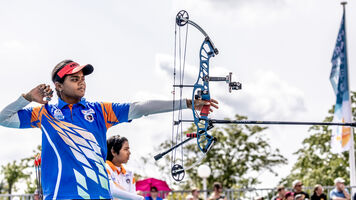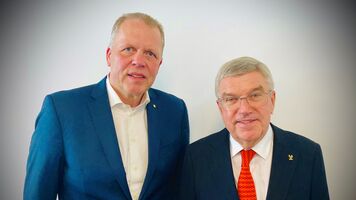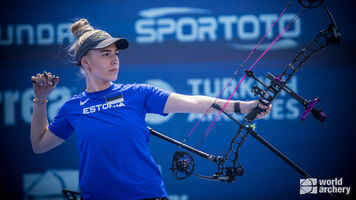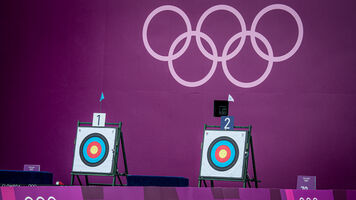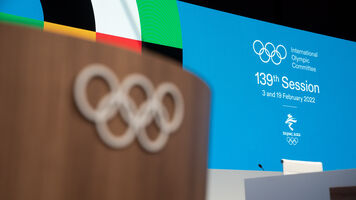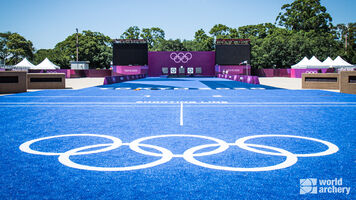Beginners’ guide to Rule 50 for archery at the Tokyo 2020 Olympic Games

Rule 50 is an infamous and very official name for the restriction of advertising in competition venues at the Olympic Games.
It’s often – wrongly – assumed in archery that it’s primarily aimed at logos on equipment. But, actually, it’s things like bows and arrows that are among the few items largely exempt from the restriction.
Rule 50 is part of the Olympic Charter. It states that “no form of advertising or other publicity shall be allowed in and above the stadia, venues and competition areas” except the Olympic brand.
That’s why, while at World Archery events you’ll see branding for Hyundai and other major sponsors, there are no brand logos in Olympic arenas. The Games have commercial partners but because of Rule 50, they’re not allowed to put any advertising in the venue. Instead, branding is almost exclusively based around the Olympic rings.
It means that companies that are involved in the Games have to get creative in leveraging their sponsor relationship.
There’s an addition to Rule 50 that exempts identification of the manufacturer brand on clothing and sports equipment as long it is not “marked conspicuously for advertising purposes”.
World Archery and the International Olympic Committee publish a set of guidelines on the permitted sizes of logos on archery equipment. These archery-specific guidelines are in addition to the general guidelines for Rule 50.

Equipment logos
Equipment used at the Olympics must have been on retail for six months before the start of the Games – and the branding must be unaltered compared to that the public can buy.
Simply put, a manufacturer can’t add extra or different logos to a bow taken to Tokyo 2020.
On bows, bow accessories and arrows, the rule simply says that branding must not be “conspicuous advertising”. It’s generally accepted that the standard rule for clothing – the maximum size of 30cm-squared – explains what fits.
National team branding is also allowed on quivers, arrows, armguards and chestguards – and teams can use the Tokyo 2020 logo. Companies can’t.
A restriction on the size of an athlete’s name on their quiver has been brought in for the next Games. On the quiver itself, the maximum letter height is 38mm and on the belt is 18mm, while the letters must be in Roman characters.
Teams at the Olympics use uniforms provided by their National Olympic Committees, which only feature the manufacturer’s brand with size restrictions approved through an official process.
This all might sound quite restrictive compared to international archery events but, at the end of the day, an archery manufacturer will receive more exposure of their logo in an Olympic venue than one of the main sponsors of the Games. And the latter has spent many millions of dollars.

Olympic brand
Association with the Olympic brand is highly valued and costs large companies a lot of money. Given that these companies can’t then put logos in arenas, where they will be seen on television, they must leverage their connection with the Games in more innovative ways.
That’s why the use of the Olympic brand by non-sponsors is very restricted.
Companies that don’t sponsor the Games – again, doing so is very expensive – can’t use the logo, name or association in any planned advertising. Brands can, however, make encouraging or congratulatory content outside of the days of competition.
It takes effort but with thought, archery companies can maximise the opportunity the Games present.
(Editorial use of the Olympic identity is covered by a different set of rules, which is why newspapers and television stations can use the Tokyo 2020 logo.)

Athlete rights
An additional set of guidelines for athletes to allow them to better leverage their commercial sponsorships has been released in advance of Tokyo 2020.
Competitors can mention a brand in a social media post as long as the message doesn’t suggest the piece of equipment “enhanced the participant‘s performance”, adds any personal endorsement or suggests any commercial link between the company and the Games.
Rule 50 also states that athletes (and anyone else in a venue, including spectators) may not make demonstrations, political or otherwise, in Olympic venues in order to leave the focus on the competition.
There are no restrictions on expression during mixed zone interviews.

Consequences of breaking Rule 50
There is a group of people at every Olympic Games whose job is to protect the Olympic brand, monitoring inside venues, television feeds and social media to ensure Rule 50 is being followed.
In the first instance, logos that do not comply are just covered up. Usually with tape. It looks horrible. More serious – and likely continued – transgressions could be taken further through National Olympic Committees or legal action.
But it’s important to remember the purpose of Rule 50.
Restrictions on branding at the Olympic Games will keep the look and feel of Tokyo 2020 clean and the focus squarely on the athletes and competition.
World Archery sponsors can contact head of events and marketing Thomas Aubert for more advice on Rule 50.




